Top News
December 7, 2017 Ryukyu Shimpo
In November, in preparation for opening up a Western market for Ryukyu Awamori, three distilleries in Okinawa Prefecture (Chuko Awamori Distillery, Zuisen Distillery, and Kumejima’s Kumesen), along with Blueship Okinawa, a consulting company, held a marketing event in Iceland.
The results of the marketing event were finalized on December 6. During the Awamori-tasting, the Awamori received good reviews by the local consumers, who mentioned the cocktail made with an Awamori base tasted like a “high-class vodka” or “high-quality gin.”
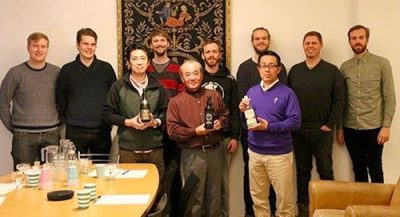
Icelanders who participated in the tasting event, (front row from left to right) Zuisen Distilliery President Manabu Sakumoto, Chuko Distillery President Tsutomu Ohshiro, and Kumejima’s Kumesen President Masaya Shimabukuro on November 11 in Reykjavik, Iceland (photograph provided by Blueship Okinawa)
The Japanese representatives felt the very real possibility of an overseas expansion.
On November 11, a total of 17 men and women in their 20s to 50s living in Iceland attended the tasting event.
A cocktail using Awamori as the base prepared by the local bartender champion was served without disclosing that it was made from Awamori to gauge the audience’s reaction.
Even for those who drank it straight, the Awamori was popular for its smoothness.
The Awamori also received praise from the bartenders as well. The bartenders said that they would definitely consider using it as a base for classic cocktails, such as the Manhattan (whiskey-based) and the Daiquiri (rum-based).
Kumejima’s Kumesen President Masaya Shimabukuro felt that “[In Iceland,] there is hardly any Japanese liquor, so we can be pioneers.” Zuisen Distillery President Manabu Sakumoto shared his view and said, “In Iceland, the liquor itself is a luxury item.
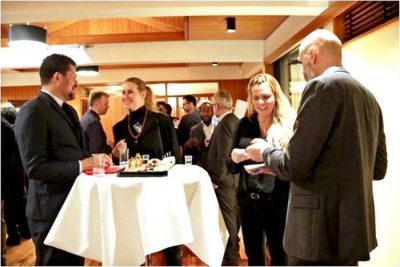
Icelander participants enjoying Awamori in Reykjavik on November 10 inside the Embassy of Japan in Iceland
I felt the popularity of Awamori in Iceland would grow if we worked on product development and advertisements that match Iceland, but emphasize Japan and Okinawa’s image and the natural yeast used in the Awamori.
On November 10, the group visited ATVR, a government agency that has a monopoly on the sale of alcoholic beverages in Iceland.
AVTR agreed to test sell Awamori at four of its flagship stores and would come up with a date in the near future.
Chuko Distillery President Tsutomu Ohshiro said, “Whether we can persuasively tell the tale of Okinawa’s climate and culture, along with the history and manufacturing of Awamori will determine [our sales strategy here on out].”
Blueship Okinawa President Hiroumi Keimatsu said, “We could feel how Awamori has the potential to rival the other hard liquors” and showed his interest in future development.
This initiative titled “Iceland Mission” took place as a result of the partnership agreement between the three distilleries and Blueship Okinawa that was arranged this past September.
Besides the tasting event that took place between November 9 and 14, there was also a reception in which foreign ambassadors were invited to the Embassy of Japan in Iceland.
(English translation by T&CT and Chelsea Ashimine)
Go to Japanese

December 8, 2017 Ryukyu Shimpo
For the first time starting on December 8, the U.S. Department of the Interior will conduct interviews with seven former Okinawan prisoners of war in order to preserve memories of Honouliuli POW Camp in Hawaii during World War II.
The site of the camp is designated as a national historic site in the United States. These testimonies will be used at a historical museum in the future.
During the Battle of Okinawa in 1945, more than 3,000 captives from Okinawa were transferred to Oahu, and many were placed at the Honouliuli camp.
The camp was closed shortly after the war, but the site was designated as a national historic site in 2015.
As there is a plan to make the camp into a national park, Rebecca Rinas of the National Park Service of the Department of the Interior visited Okinawa to investigate.
On December 7, Rinas held a press meeting and told the prefectural office that it is important to listen to the POWs’ experiences directly in proceeding with the plan.
She voiced a desire to know under what circumstances they became captives and about their experiences in the camp.
The department will interview one or two people a day until the 13th and videotape the interviews.
(English translation by T&CT and Megumi Chibana)
Go to Japanese
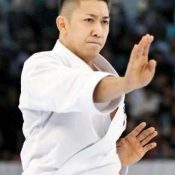
December 11, 2017 Ryukyu Shimpo
On the final day of the Japan Cup Karatedo Champsionship at the Nihon Budokan in Tokyo December 10, Ryo Kiyuna (Ryuei Ryu Ryuho-kai) won his sixth-straight Emperor’s Cup, and Kiyou Shimizu (Miki House) won her fifth straight Empress’s Cup in the individual kata.
Both Kiyuna and Shimizu won gold at the World Championships in the same event earlier this year.
Kiyuna overwhelmed the competition, going undefeated in all four matches of the day, winning each by a score of 5-0.
He faced Issei Shimbaba (Seino Transportation) in the championship round, and swept the decision of all five judges with his performance of a convincing Anan kata.
In the male individual catchweight (no weight classes) kumite, Daisuke Watanabe (Japan Karate Shoto Federation (JKS) won his first Emperor’s cup by unseating four-time 84kg-division kumite world champion Ryutaro Araga (Araga Dojo).
The championship match ended in a 2-2 draw, however Watanabe was awarded the championship based on a total cumulative point tie-breaker.
In the women’s competition, Ayumi Uekusa (Koei Keibi Hosho), world champion in the over 68kg division, won her third-straight Empress’s cup defeating Miho Miyahara (Teikyo University) 2-1 in the championship match.
(English translation by TC&T and Sam Grieb)
Go to Japanese
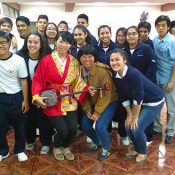
December 4, 2017 Correspondent Heiji Taira of Ryukyu Shimpo reports
On November 6, La Unión Private Elementary and Middle School for students of Japanese descent in Lima, Peru, held a lesson on peace education as part of an integrated curriculum.
Japan International Cooperation Agency (JICA) volunteer Lima Tokumori of Naha City delivered a lecture to the third-year middle school students in attendance.
Tokumori began by greeting the students using Shimakutuba (Okinawan languages).
After teaching the students about the difference between haisai and haitai (namely that men say haisai and women say haitai as a greeting), she explained more about Okinawa’s unique culture.
Before showing the documentary Okinawa: Yomigaeru Senjyo about a woman who lived through the Battle of Okinawa, Tokumori said, “There are many fun things about Okinawa, but today I want to teach you all about Okinawa’s sad history, as well.”
After showing the film, she conveyed to the students how important peace education, the peace movement slogan nuchi du takara (life is a treasure), and “Irei no Hi” (Okinawa Memorial Day) are to Okinawan people
Next, students divided into groups to earnestly discuss their feelings about the documentary, and how to create a peaceful world.
At the end of her lesson, Tokumori explained the history of kankara sanshin (sanshin made from cans), and performed Asadoya Yunta on her own sanshin.
La Unión’s principal Edith Martínez and second secretary Masaki Hisano in charge of culture and education at Peru’s Japanese embassy attended the special lesson.
Hisano said: “There are people with differing opinions around the world.
The important thing is to respect others’ opinions so we can live together. I want you to tell me how we can all create a peaceful world together.”
Translator’s note:
Shimakutuba is not to be confused with uchinaaguchi. Shimakutuba is a term for all dialects originating within Okinawa Prefecture, whereas uchinaaguchi refers to the dialect mainly used centrally on Okinawa Island
(English translation by T&CT and Erin Jones)
Go to Japanese
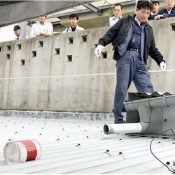
December 8, 2017 Ryukyu Shimpo
A plastic canister landed on the metal roof of the Futenma Baptist Church’s Midorigaoka Nursery School in Nodake, Ginowan, around 10:20 a.m. on December 7.
No people were injured. Right around the time of the dropped tube, a U.S. military CH-53 heavy-lift transport helicopter was flying overhead, and investigators have indicated that, “the characteristics of the dropped object as well as the circumstances suggest a high probability that it came from a U.S. military vehicle.”
The Ginowan Police department are continuing to investigate the cause of the dropped object.
When asked for comment, a representative for the U.S. Marines responded, “We are carefully investigating the matter.”
According to a witness, at around 10:15 a.m. a CH-53 was seen taking off from MCAS Futenma in the direction of Nodake.

The plastic canister dropped from a U.S. helicopter
Nursery School Principal Takeshi Kamiya said that there were around 60 children in the school around the time of the drop.
The children were playing outside, having just finished practicing for the Christmas play when the canister landed on the metal roof of the one-year-old’s class.
Had the canister landed a few feet from where it did, it would have been right in the playground.
According to Ginowan Police, the canister is around 9.5 cm long, a diameter of around 7.5 cm, 8 mm thick, weighing around 213 grams. The message “Remove before flight” is written on the front in English.
According to the U.S. military’s website, the canister is very likely a cover for an instrument that detects abnormalities in the motion of the propeller.
In the afternoon December 7, Okinawa Defense Bureau head Koichiro Nakajima visited Ginowan Mayor Atsushi Sakima and reported, “I went to visit the site as soon as I heard the news. We are currently investigating and reaching out to the U.S. military for inquiry.”
Mayor Atsushi pretested, “Can’t we definitively say that this belongs to the U.S. military? Something dropping onto a nursery school is about as serious as a situation can be.”
The Ginowan City Assembly reached out to the Special Committee on Bases for help with the response.
Okinawa Governor Takeshi Onaga, in an indication that the prefectural government had determined a high likelihood that the part came from a CH-53 said, “Since single misstep can lead to a dangerous incident, this is a very serious matter.”
Chief Cabinet Secretary Yoshihide Suga commented, “The people of Okinawa have no choice but to feel uneasy about this, not to mention the fact that it involved a nursery school.”
(English translation by T&CT and Sam Grieb)
Go to Japanese
November 30, 2017 Ryukyu Shimpo
The number of tourists visiting Okinawa in 2017 may exceed that of Hawaii, which is considered a model for Okinawa tourism. From January to September, 7,115,500 people visited Okinawa, an increase of 8.9 percent compared with the same period last year, while the number of tourists to Hawaii was 7,011,706 people, an increase of 4.9 percent. It is assumed that the gap will shrink because Hawaii expects to have many tourists for the year-end and New Year holidays. If the growth rate of Okinawa continues, the annual number of tourists in Okinawa is estimated to be 938 million people. This is higher than the yearly estimate of 9,347,850 people announced by the Hawaii Tourism Authority on the 22nd.
The number of tourists entering Okinawa has been reaching new records for four consecutive years. In 2016, the number was 8,613,100 people, only 320,000 people less than the figure for Hawaii, the world’s leading ocean resort.
Since the start of this year, Okinawa tourism has maintained a strong momentum, with tourists numbers in August exceeding one million in a single month for the first time. Although the number in October was a record high, it was only 4.1 percent higher than the same month the year before because a typhoon attacked the main island for two consecutive weeks. Whether the annual number exceeds that of Hawaii throughout the year will depend on November and December.
Tourists from abroad make up much of the increase. The number of large cruise ships was 387 in 2016, this year it has increased to 502 (annual schedule). Low-cost carrier (LCC) flights also opened new routes to cities overseas. Direct flights to Bangkok in February and to Singapore in November have also launched.
On the other hand, the average days spent per tourist in 2016 was 3.7 days in Okinawa compared to Hawaii, which was 8.9 days. The consumption amount per tourist in Hawaii is about 210,000 yen, whereas in Okinawa it is less than half that at approximately 75,000 yen.
(English translation by T&CT and Megumi Chibana)
Go to Japanese
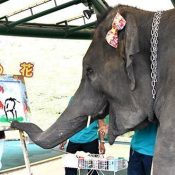
November 23, 2018 Ryukyu Shimpo
(Okinawa) On November 18, a welcome party was held for Yumeka, a 10-year-old female Asian elephant who has come from Ichihara Elephant Kingdom, a zoo in Chiba Prefecture, to Okinawa Zoo & Museum.
Yumeka will stay at Okinawa Zoo & Museum for six months to a year in order to try to get pregnant.
She was welcomed by 150 zoo visitors and staff. Yumeka put on a show for the visitors, playing the tambourine and showing off her art skills.
No elephant born in Japan has ever borne a child, so if Yumeka gives birth she will be the first.
Yumeka appeared at the welcome party with a traditional Okinawan ryusou-patterned ribbon on her ear.
She sometimes surprised the visitors by trumpeting.
Three-year-old Tadashi Henza’s eyes were wide with surprise as he remarked, “It was so big!’
His cousin, Ichika Miyazato, age five, said, “She was very cute. I hope she has a girl.”
(Translation by T&CT and Sandi Aritza)
Go to Japanese
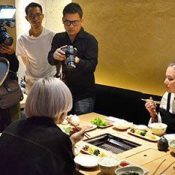
December 5, 2017 Ryukyu Shimpo
On December 4 ML Sarali Kitiyakara of Thailand’s royal family, who also does work as a television personality, came to Okinawa to film an overseas vacation television program with the National Broadcasting Services of Thailand (NBT). She will stay on Okinawa Island visiting well-known tourist attractions until December 13, partaking in Okinawan cuisine and sightseeing in order to convey Okinawa’s charm for the program. Okinawan businesses invited the NBT to film its program in Okinawa as a way to draw more tourism from Thailand. On the first day, the team filmed at the restaurant “Yakiniku: Ryukyu no Ushi” in Makishi, Naha City, which offers prefecturally-produced and domestically-produced beef.
ML Sarali said: “I have seen many kinds of castles, yet I am taken with Shuri Castle’s beauty. Okinawa’s music, cuisine, and such are distinct from those of other regions.”
She went on to say, “The people of Thailand like Japan, so if they know of Okinawa as well I think they will take interest in it.” In addition, she expressed hope that the friendly relationship between Thailand’s royal family and Japan’s imperial family will flourish.
Jessica Paraphan who works as a reporter for the program said, “I look forward to diving in Okinawa’s beautiful ocean.”
The same day, ML Sarali went to the Okinawa Convention and Visitors Bureau and spoke with the bureau’s president, Chokei Taira. Taira explained ties between Okinawa and Thailand, such as the use of rice from Thailand in the production of awamori, an Okinawan liquor. He also mentioned the route between Naha and Bangkok that Peach Aviation established, and voiced his hope that it will promote cultural exchange between Okinawa and Thailand. This vacation program introducing Okinawa is planned for broadcast in Thailand between February and March next year.
(English translation by T&CT and Erin Jones)
Go to Japanese

December 2, 2017 Ryukyu Shimpo
Kenneth Franklin Shinzato (formerly Gadson) was given a life sentence for the April 2016 rape and murder of an Okinawan woman at his sentencing December 1 at the Naha District Court.
The 33-year old defendant remained silent throughout the trial. During the sentencing, there were angry shouts from Okinawan residents proclaiming the defendant, who was not forthcoming with the truth and did not apologize for his actions, “had no remorse,” and also claimed that, “the incident happened because of there are U.S. military bases.”
The victim’s family, who ask for capital punishment during the trial, said, “For us, every day is sadness and suffering.
That will probably continue for as long as we live,” and that with carrying such sadness, the trial was an afterthought.
At the outset of the sentencing, the presiding judge pointed to Shinzato and commanded that he, “must stand where he was. I sentence you to life in prison.”
As the judge read the sentence, reporters who rushed to fill the seats in the court in order to break the news of the sentencing immediately turned to Shinzato, who listened to the English interpretation of the sentence without expression.
When the victim’s parents heard the sentence, they rubbed their eyes, disappointed not to get the capital punishment they had requested.
Shinzato, who appeared in court wearing a white T-shirt and blue jeans, listened to the approximately 40 minute ruling leaning deeply in his chair resting his chin on his left hand.
A family whose daughter’s future was tragically ripped away just after her coming-of-age ceremony.
The father sat on the prosecution’s bench directly across from Shinzato, seated in the defendant’s chair.
Wearing funeral attire of a black shirt and suit, the father wiped his face repeatedly with a blue towel while listening to the verdict, and raised his head to look at the ceiling, nose completely red.
Occasionally, the father would come to look at Shinzato, and when their gazes would meet he would quickly close his eyes and look down.
The mother of the victim, who sat in the spectators’ gallery, covering her mouth with a pink handkerchief and wiping away tears again and again as the ruling was being read.
At times she would also stare in the direction of the defendant.
In giving his grounds for the decision, the judge read proclamations such as, “The parents who survive the victim have every right to demand capital punishment,” and “If the defendant had even a bit of respect for human life, he would have stopped at some point,” occasionally eliciting nods from the grieving parents.
As the defendant was being led from the courtroom, the victim’s mother covered both of her hands with her handkerchief and began to wail uncontrollably, her voice echoing throughout the chamber.
After the trial concluded, the mother was assisted out of the courtroom by some women who had accompanied the victim’s family to the trial.
(English translation by T&CT and Sam Grieb)
Go to Japanese
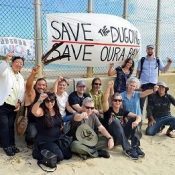
November 30, 2017 Ryukyu Shimpo online edition
On November 30, the plaintiffs in the dugong lawsuit against the U.S. came to i
nspect Henoko.
This lawsuit is aimed at stopping construction of the Futenma Air Station replacement facility, as the construction will affect precious dugong.
The plaintiffs comprise American and Japanese citizens, and environmental protection groups including the American organization Center for Biological Diversity.
That morning, the plaintiffs joined the ongoing sit-in protest against replacement facility construction in front of Camp Schwab’s gate and socialized with the local citizens there.

On November 30 in front of the gate to Camp Schwab, the Center for Biological Diversity’s Peter Galvin (right) shakes hands with Fumiko Shimabukuro (left) during the sit-in protest.
A founder of the Center for Biological Diversity, Peter Galvin, gave a statement that was received with resounding applause: “My dream is to swim together with the dugong in Henoko at a time that Camp Schwab will not have been expanded into ocean.
It is a sad thing that the U.S. military is oppressing the peaceful people of Okinawa.
When I return to the U.S. I will double my efforts in the fight against building the base.
We will not give up.”

The Center for Biological Diversity’s Mati Waiya (right) offers a prayer for the sit-in protestors on November 30 in front of the gate to Camp Schwab.
Mati Waiya, a Native American among the plaintiffs, offered a prayer in traditional Chumash style for the sit-in protestors.
(English translation by T&CT and Erin Jones)
Go to Japanese
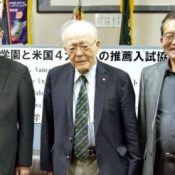
November 26, 2017 Ryukyu Shimpo
On November 24, Okinawa Okisho High School in Naha City announced that it entered an agreement for enrollment by recommendation with four U.S. universities.
Okinawa Okisho High School Vice Chairman Masaichiro Nashiro and NPO Ryukyu America Historical Research Society Chairman Shizuo Kishaba held a press conference at the school.
The agreement is with four state universities, namely Clark College and Washington State University in Washington, Idaho State University, and Kapi’olani Community College in Hawaii.
The agreement entails the Principal and Chairman Masajiro Nashiro recommending any 12th grade student with an Eiken (standardized English proficiency test) level 2 or higher and an Okinawa Karate certification for enrollment to a school of the student’s choice.
Those who are admitted will study at the school in the states for two years.
After that, the student can potentially transfer to a different four-year college in the states or transfer to a school in Japan. Vice Chairmen Nashiro has high hopes and said, “In today’s era, we need people who know two or more cultures. We hope the students will learn in the states, come back and succeed.”
(English translation by T&CT and Chelsea Ashimine)
Go to Japanese














 Webcam(Kokusai Street)
Webcam(Kokusai Street)


